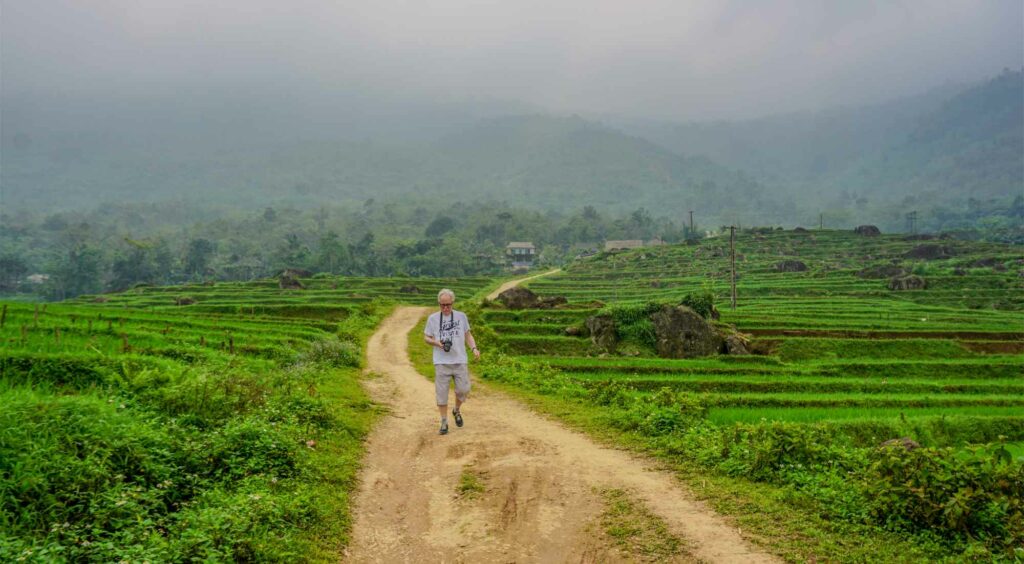What to expect when trekking in Pu Luong
Trekking in Pu Luong is all about escaping the crowds and getting close to nature and local life. The trails are quiet and scenic, the landscapes are diverse, and the villages you pass through still feel untouched by tourism. Compared to more developed trekking destinations like Sapa, Pu Luong offers a rawer, more peaceful experience.
Scenery & Ethnic Villages
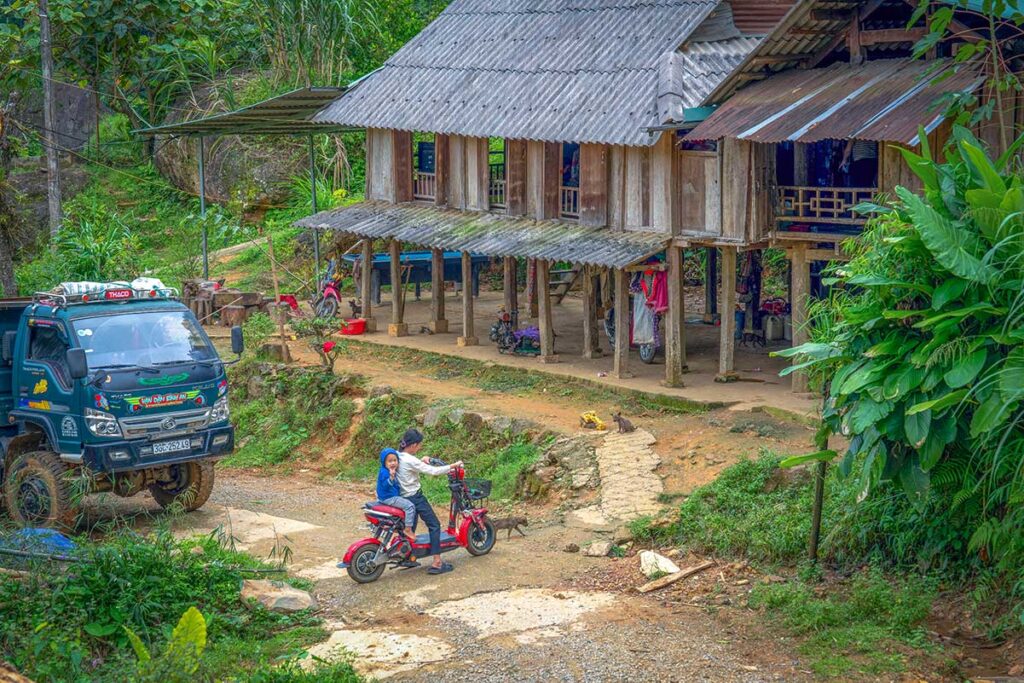
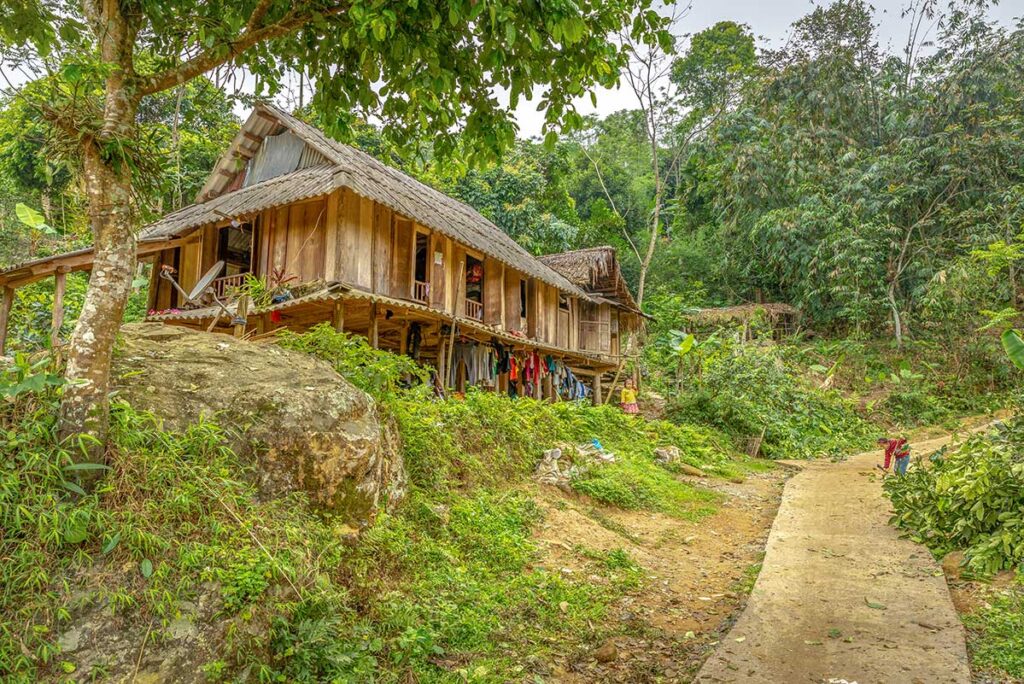
A typical trek in Pu Luong takes you through some of Vietnam’s most beautiful countryside. You’ll walk past terraced rice fields carved into the hillsides, through valleys surrounded by limestone mountains, and along paths shaded by bamboo and forest. The views often change as you move between jungle areas, open farmland, and small hilltop lookouts.
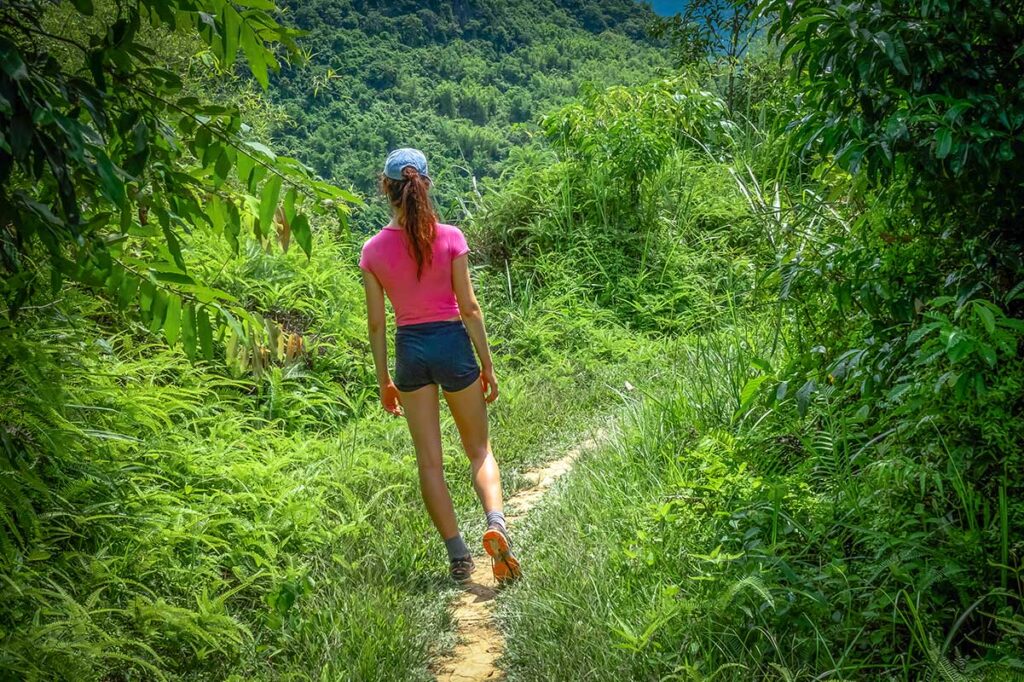
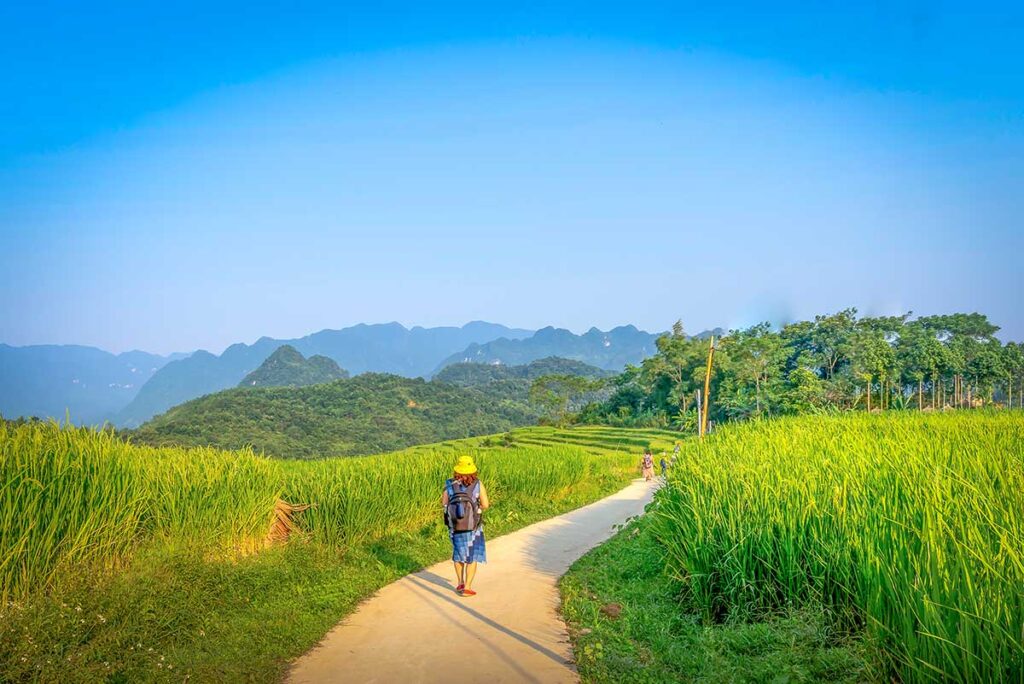
Along the way, you’ll encounter Thai and Muong ethnic minority villages. These communities live in wooden stilt houses and maintain a traditional lifestyle centered around farming, weaving, and raising animals. It’s not unusual to pass buffalo working the fields, see handwoven textiles drying in the sun, or catch the sound of children playing near a stream.
Half-Day or Full-Day Treks
Treks in Pu Luong are typically half-day or full-day hikes. There are no multi-day trekking routes where you walk from village to village and stay overnight in a different place each time. Instead, most people stay in one lodge or homestay and do a day trek from there.
Some treks start directly from your accommodation, while others begin with a short drive to a different part of the reserve. Many routes are one-way: you hike through the countryside and end near a road where a car or motorbike will meet you and bring you back. If you want to explore more than one area, you can do two different treks on two different days, returning to the same place each night.
Additional Activities During or Around Treks
1. Countryside Experiences
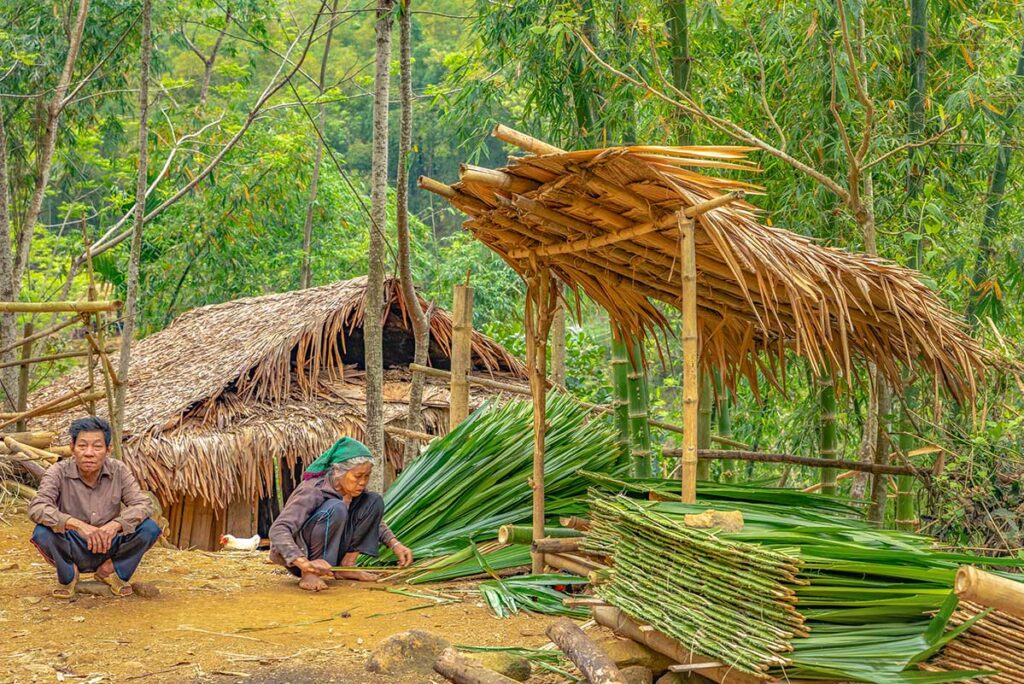
Trekking in Pu Luong is not a curated cultural tour — it’s an immersion in real countryside life. Local guides might take time to explain farming practices, point out traditional weaving techniques, or even let you try simple activities like husking rice or riding a buffalo. But it depends on the moment and the people you meet. Most villagers are friendly but reserved, and tourist-focused experiences are rare.
2. Bamboo Rafting
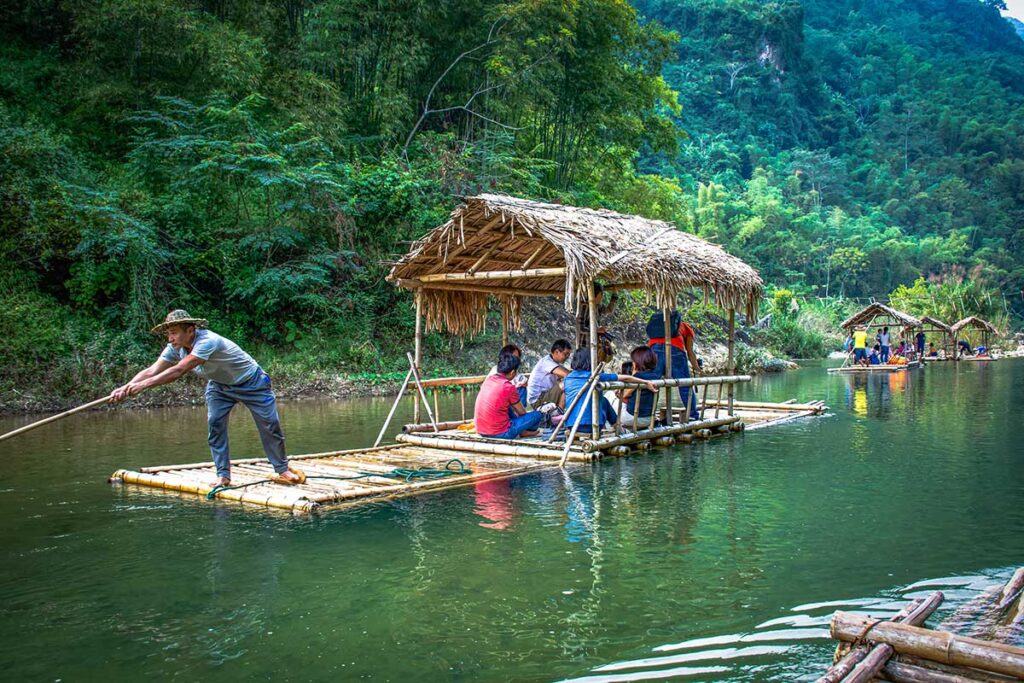
In some areas, especially near the Cham Stream, you can add a short bamboo rafting experience at the end of your trek. It’s a relaxing way to enjoy the scenery and rest your legs after a few hours of hiking.
3. Swimming in Streams and Waterfalls
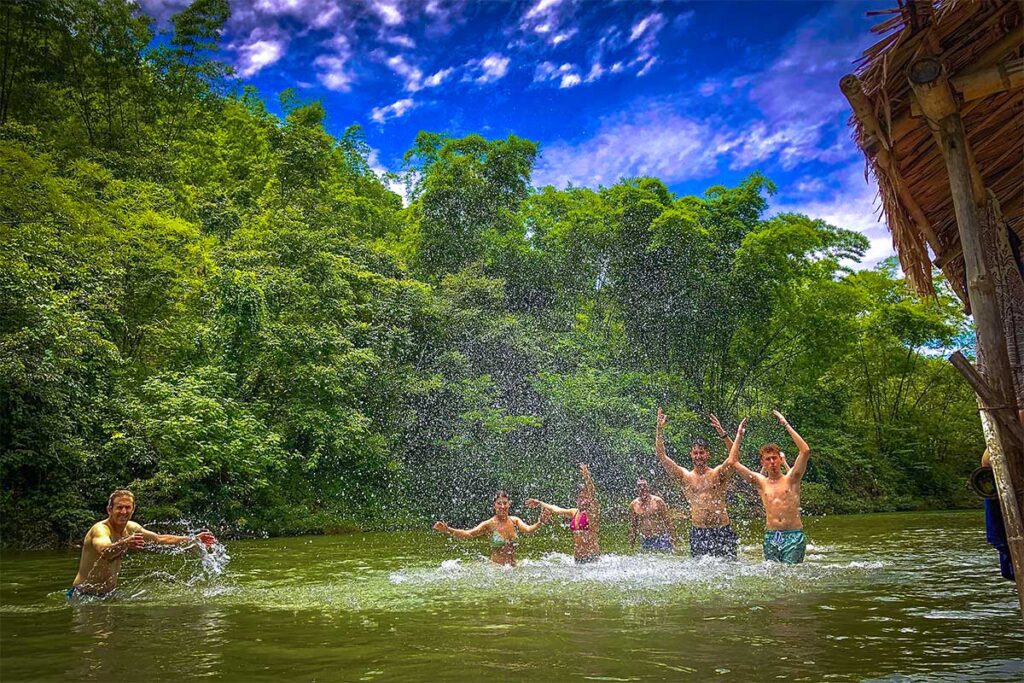
If the weather’s warm and the water levels are right, you might stop to swim in a stream or at a waterfall — especially near Hieu village. It’s not guaranteed on every trek, but your guide can often adjust the route if swimming is something you want to include.
4. Cycling
Some travelers choose to combine trekking with cycling to explore more of the area. You might trek in the morning and cycle in the afternoon, or do a cycling day before or after your hike. The terrain varies, but many paths are suitable for mountain bikes or e-bikes.
Do you need a guide for trekking in Pu Luong?
Yes — for most travelers, trekking in Pu Luong is best done with a local guide. While it’s technically possible to walk on your own, the trails are unmarked and often not visible on Google Maps. Without local knowledge, it’s easy to miss the most scenic paths that cut through rice fields, forest patches, and small villages.
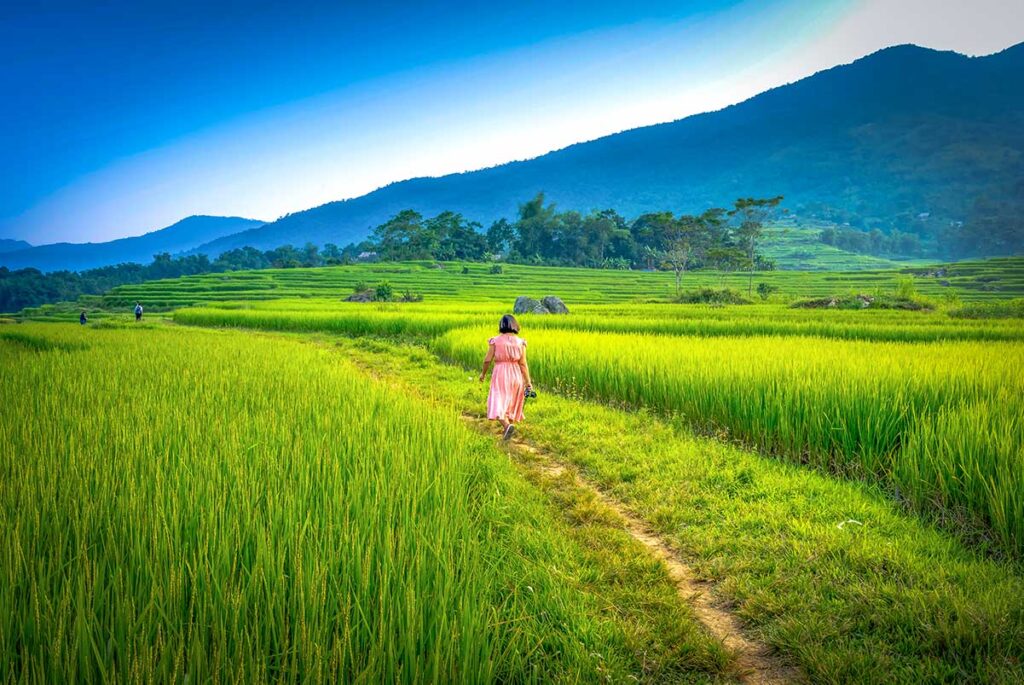
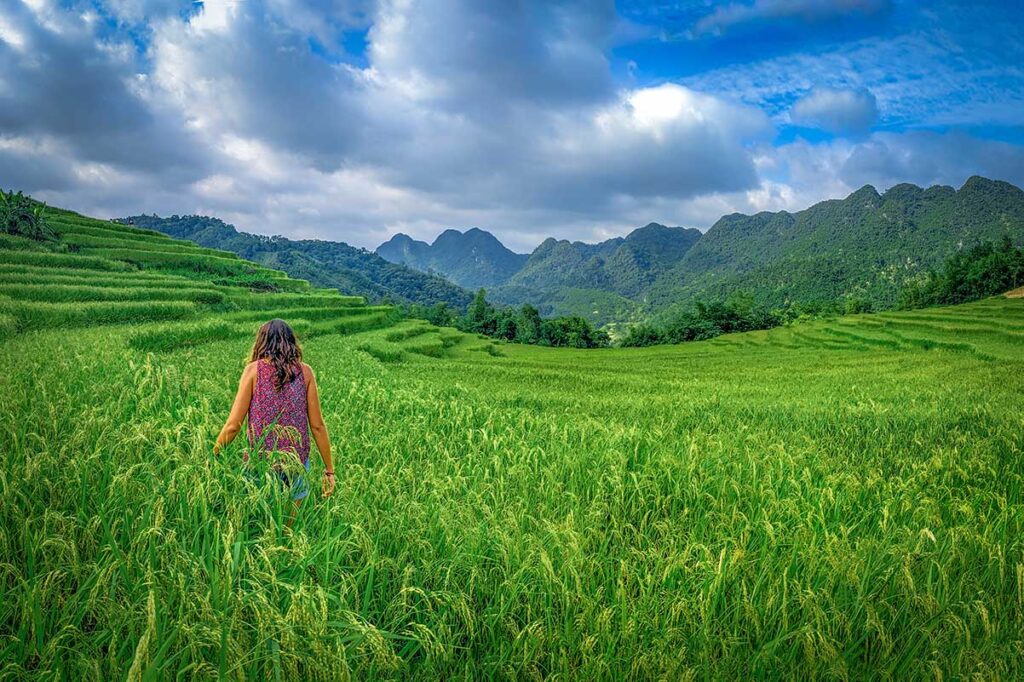
Another reason to go with a guide is that many treks in Pu Luong are designed as one-way hikes. You might start the walk in one area and end near a road where a driver picks you up and brings you back to your accommodation. This flexibility is hard to arrange on your own unless you’re just walking out and back the same way.
That said, if you want to do a short, independent walk near your lodge or around a nearby village, that’s certainly possible. Just don’t plan long routes or try to cross the valley without guidance — it’s easy to get lost, and there’s little signage or infrastructure to help you navigate.
Popular trekking routes in Pu Luong
While trekking in Pu Luong doesn’t follow set or heavily mapped-out trails like in places such as Sapa, there are a few standout routes that most local guides recommend. These hikes combine scenic beauty, cultural encounters, and a bit of adventure — and they’re often the highlight of any stay in the area.
1. Bat Cave (Kho Muong Village)
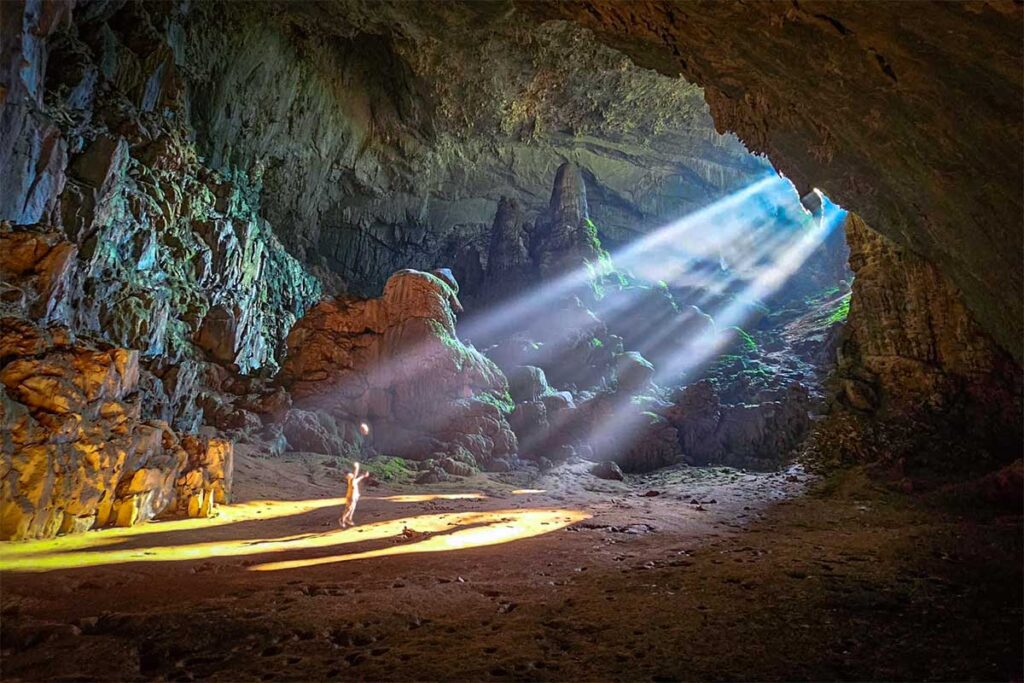
This is one of the most accessible and rewarding half-day treks in Pu Luong. You’ll start by walking through rice terraces and remote Thai villages, where life moves slowly and stilt houses line the valley floor. The scenery is peaceful and lush, especially in the green or harvest season.
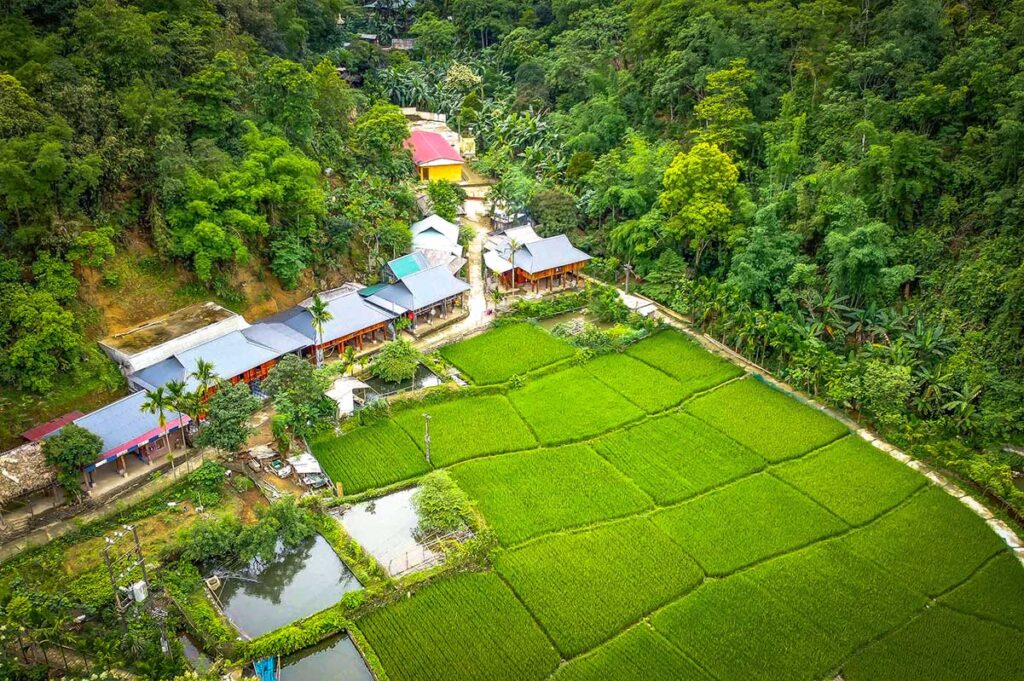
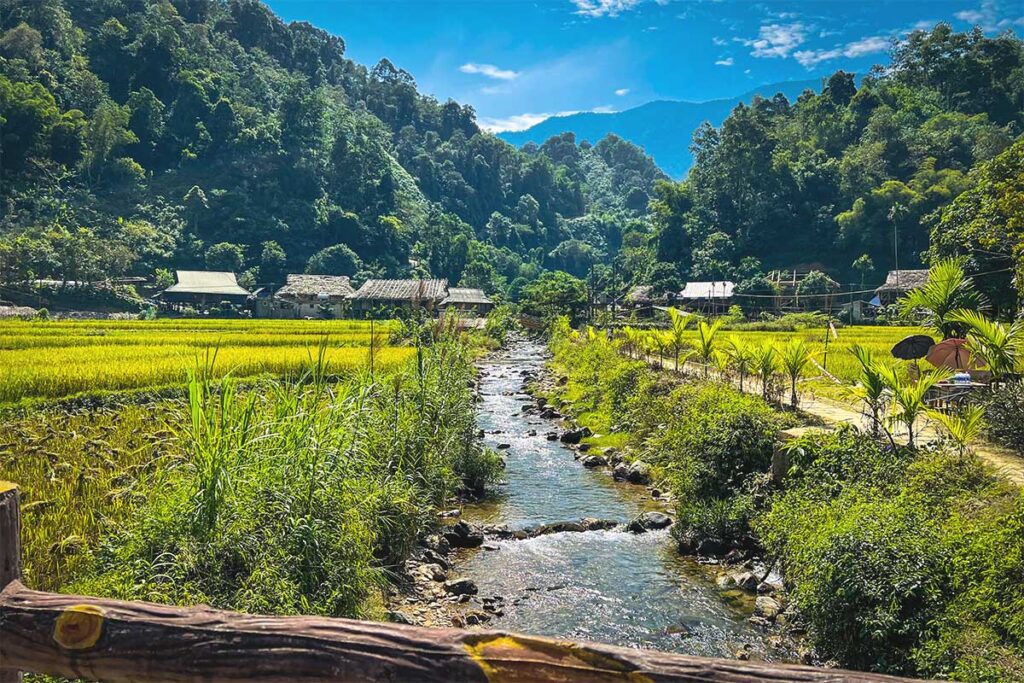
As you continue, the trail winds into the hidden valley of Kho Muong, surrounded by limestone cliffs and forest. The highlight here is Doi Cave, more commonly known as the Bat Cave. It’s the largest cave in Pu Luong and can be explored safely with a guide, especially when the weather is dry. Inside, you’ll find a cool, dramatic cavern filled with limestone formations — and sometimes bats, depending on the season.
Most treks to Bat Cave are half-day outings. Some start directly from a lodge nearby, while others include a short drive to the starting point. You can return by the same trail or take a different route back to make a loop or reach a pickup spot.
2. Hieu Waterfall
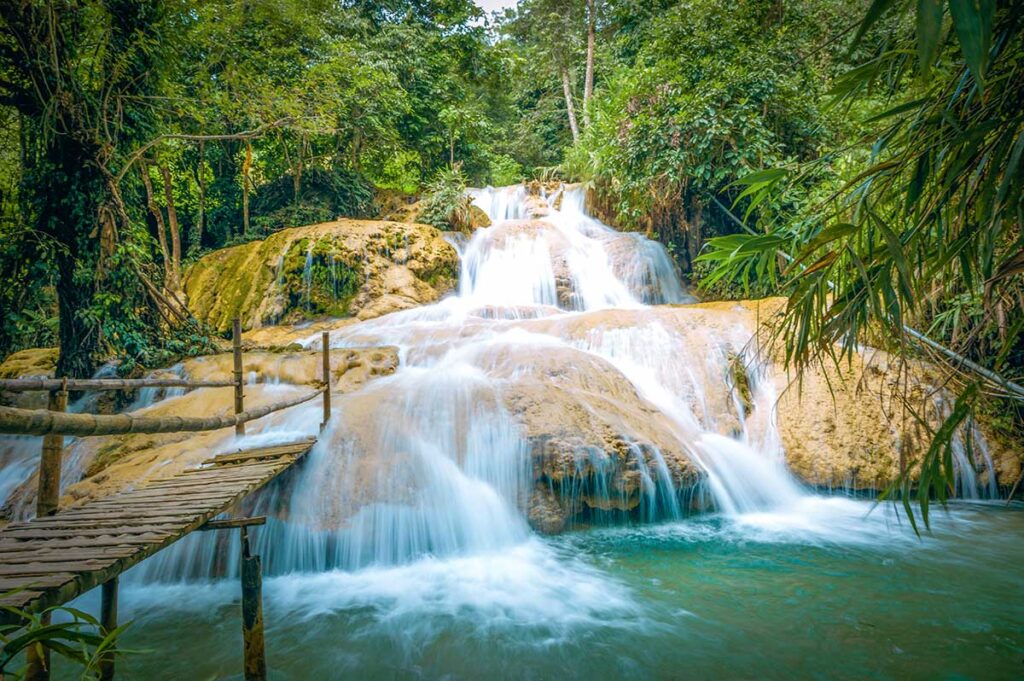
This is a longer and more adventurous day trek that includes jungle paths, hilltop views, and one of the most beautiful waterfalls in the region. The trek usually starts near Pho Doan Market (on Thursdays and Sundays, you can visit the market before you hike). From there, you follow a narrow trail through forest and farmland, passing scattered homes and grazing buffalo.
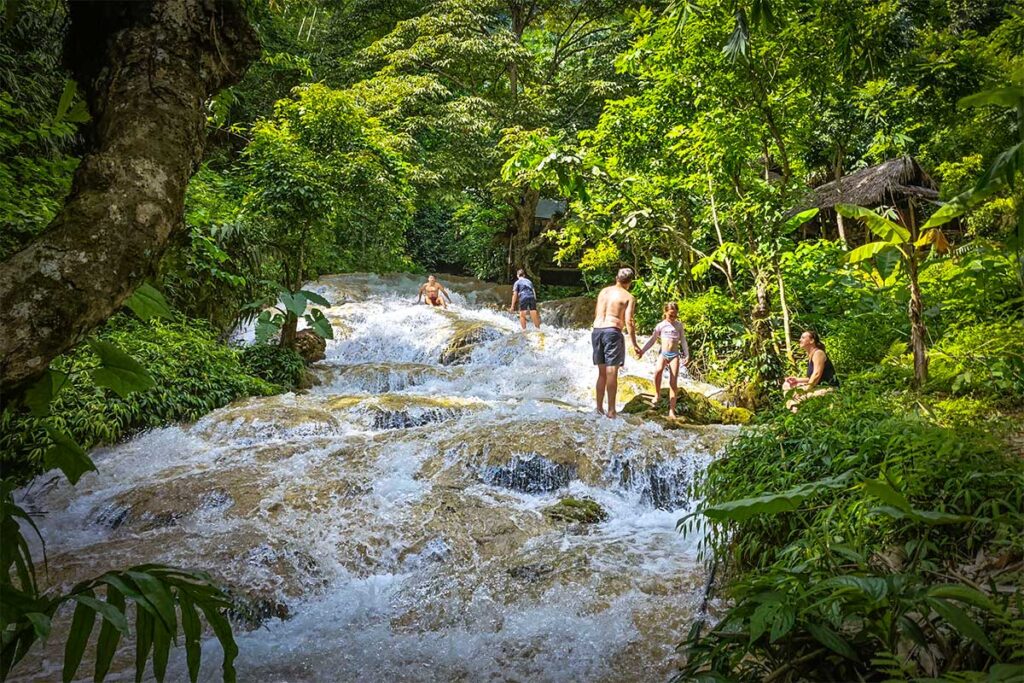
Eventually, the trail descends into the valley of Hieu Village, a remote cluster of stilt houses surrounded by terraced fields and overlooked by forested slopes. At the base of the valley is Hieu Waterfall — a multi-tiered stream cascading over smooth rocks into swimmable pools. It’s a great place to take a break, swim, or simply relax after the hike.
After lunch in a local homestay, the experience often ends with a short bamboo rafting ride on Cham Stream, before being picked up and driven back to your accommodation. This full-day trek is ideal if you want to combine nature, light adventure, and a glimpse of local life — all without feeling rushed.
Best time for trekking in Pu Luong
Trekking in Pu Luong is possible in every season, but the experience will change depending on the time of year. Some months offer lush green rice fields, while others bring cooler weather or dry trails. Below is a seasonal overview to help you decide when to go. For a more detailed month-by-month breakdown, check our guide: Best time to visit Pu Luong
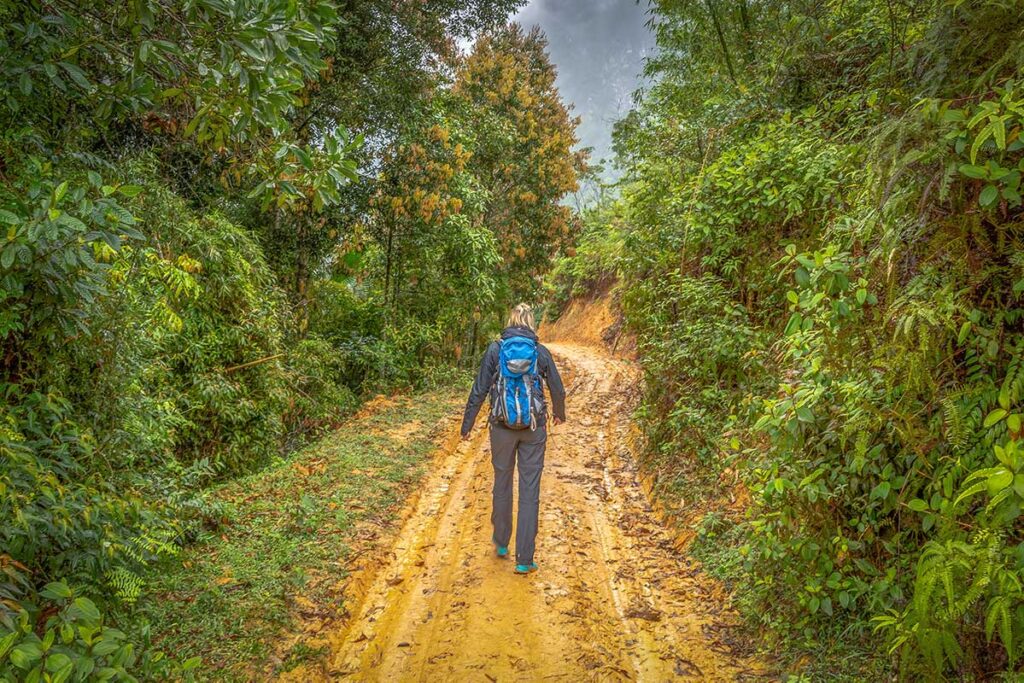
Spring (February–April): Great Weather & Visible Rice Fields
Spring is one of the most pleasant times to go trekking in Pu Luong. The temperatures are comfortable, the weather is generally dry, and the landscape starts turning green again after winter. Early-season rice fields are visible, though not fully grown — making it a peaceful time for photography and longer hikes.
Summer (May–August): Muddy Trails, Lush Fields & Waterfalls
Summer brings dramatic landscapes, with rice terraces at their greenest and waterfalls at full flow. It’s the most scenic time for trekking in Pu Luong — but also the most humid. Expect hot days, slippery trails after rain, and occasional downpours. If you don’t mind the heat and a bit of mud, the views are worth it.
Autumn (September–November): Dry, Scenic, and Harvest Season
This is often considered the best time of year for trekking in Pu Luong. The weather is cooler, the skies are clearer, and the rice terraces turn golden as harvest season arrives. Trails are dry and easier to walk, making it a perfect window for longer day hikes and village visits.
Winter (December–January): Cold, Dry & Mystical Atmosphere
Winter is the driest season, but also the coldest. Morning mist often settles over the valleys, creating a moody, atmospheric feel — especially beautiful for sunrise treks. It’s a quiet time for tourism, and while the rice fields are empty, the peacefulness and crisp air still make for a memorable hike. Just be sure to bring warm layers.
How to arrange a trekking tour in Pu Luong
There are two main ways to arrange trekking in Pu Luong: you can book it through your accommodation once you’re there, or plan everything in advance as part of a multi-day tour package from Hanoi.
Through Your Accommodation
Most lodges and eco-retreats in Pu Luong can organize a guided trek for you, either starting directly from the property or with a short transfer to a nearby trail. These places usually work with local guides who know the area well and can tailor the route to your fitness level and interests.
Homestays sometimes offer trekking too, but not always. Many are run by local families with limited English and fewer structured activities. That’s part of the charm, but it also means you should check ahead if trekking is something you definitely want to do. Communication can sometimes be a challenge, especially if you’re traveling without a Vietnamese-speaking companion.
Pre-arranged Tour from Hanoi
If you prefer everything taken care of in advance, the easiest way to experience trekking in Pu Luong is through a package that includes your transfers, accommodation, and guided hikes. These tours typically depart from Hanoi and can include 2 to 4 days in Pu Luong — with options for bamboo rafting, cycling, or even adding nearby destinations like Mai Chau or Ninh Binh.
You can choose to stay in a comfortable lodge or opt for a more local experience in a stilt house homestay. Either way, it’s a hassle-free way to enjoy Pu Luong without worrying about logistics or language.
Ready to trek Pu Luong?
Stay in a lodge or homestay, explore scenic trails, and combine it with bamboo rafting or cycling. Tours from Hanoi are fully customizable and can be combined with Mai Chau or Ninh Binh.
What to bring & Travel tips for trekking in Pu Luong
Packing right makes a big difference when trekking in Pu Luong. The hikes here aren’t extremely difficult, but conditions can change quickly depending on the weather and season. Here are the essentials to help you stay comfortable, respectful, and prepared.
Walking shoes
A pair of good walking shoes is a must. You don’t need heavy-duty hiking boots unless you’re planning other treks elsewhere in Vietnam. Lightweight, breathable shoes with decent grip are perfect for the uneven terrain, especially on muddy or rocky sections of the trail.
Seasonal clothing
Dress in layers and adjust your clothing based on the time of year:
- Spring (Feb–Apr): Light layers and long sleeves for sun protection. The weather is mild and ideal for walking.
- Summer (May–Aug): Expect heat and humidity. Bring quick-drying clothes, a sun hat, and a rain jacket in case of sudden showers.
- Autumn (Sep–Nov): Comfortable trekking weather. Layers are still useful, especially early morning or late afternoon.
- Winter (Dec–Jan): It can get cold, especially at night. Pack a warm layer, windbreaker, and socks for chilly mornings.
Swimwear & Towel
You may not plan to swim, but after a few hours of hiking, a clear stream or cool waterfall can look very tempting. Bring swimwear and a quick-drying towel, especially in the warmer months. Even if you don’t end up using them, you won’t regret having the option.
Respect the Locals
Pu Luong is not a tourist village — it’s home to real communities who live off the land. Be mindful of their space and traditions:
- Don’t enter stilt houses without an invitation
- Always ask before taking close-up photos of people
- Avoid stepping into or across rice fields — this is people’s livelihood, not scenery
Other tips
- Bring cash – There are no ATMs in the reserve, and small tips or snacks might require cash
- Start early – The sun can be strong by late morning, especially in summer
- Be mindful with sunscreen and bug spray – If you plan to swim, apply them afterward to protect the water
Trekking in Pu Luong vs Trekking in Sapa
Trekking in Pu Luong and trekking in Sapa both offer incredible views and cultural encounters, but the experience is quite different. Your choice depends on what kind of traveler you are — and what kind of trekking you enjoy.
Pu Luong is quieter, more rural, and far less visited. Trails are unmarked, there’s little tourist infrastructure, and the villages feel raw and untouched. You won’t find souvenir shops or crowds of day-trippers here. It’s ideal for travelers who want authentic countryside life, peaceful rice terraces, and a more off-the-beaten-track feel.
Sapa, on the other hand, is well-known and much more developed for tourism. There are more trekking routes, local guides who speak fluent English, and the option for multi-day treks where you hike from one village to the next, staying overnight along the way. The scenery is dramatic, and there’s a wider mix of ethnic cultures, but also more visitors and organized tours.
In short:
Choose Pu Luong for rustic beauty, quiet trails, and authentic village life.
Choose Sapa if you want more hiking infrastructure, easier logistics, and multi-day trekking adventures.
